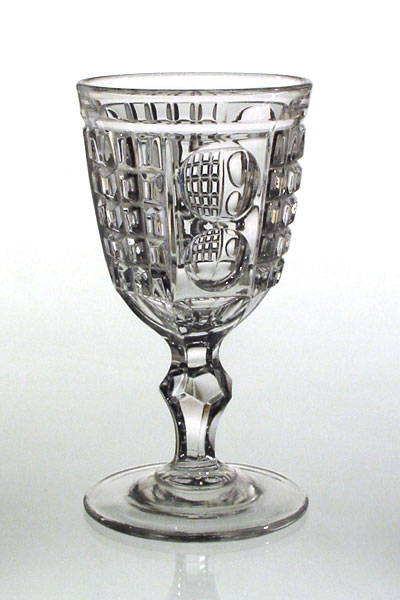
Pattern Name:WAFFLE AND THUMBPRINT
Pattern Motif:Geometric
Glass Type:Flint
Era:1860s
Description:50 Favorites - 9.
The WAFFLE AND THUMBPRINT goblet can be found with three different types of stems, each of which is illustrated by S. T. Millard. The first has offset flutes meeting at a central knob. The second is a paneled-baluster form with the buldge just below the goblet bowl. The third stem type is also paneled but with a large round buldge just above the foot. Illustrations of the goblets with the offset flute system appear in the New England Glass Company's c.1869 trade catalog and in the 1856-1857 advertisement by Curling, Robertson & Company of Pittsburgh (Innes, Pittsburgh Glass 1797-1891). A Spoon holder in the pattern also appears in an 1861 trade catalog issued by the Pittsburgh firm of James B. Lyon & Company (Rakow Library, The Corning Museum of Glass). John and Elizabeth Welker speculate that Lyon may have acquired WAFFLE AND THUMBPRINT molds from Edward Dithridge, who took over Curling about 1860. Other authors claim the pattern was made in Sandwich. Ruth Wedd Lee records the discovery of fragments at the Sandwich factory site, while Raymond Barlow and Joan Kaiser assign a Sandwich attribution to lamps combining glass WAFFLE AND THUMBPRINT font holders with metal safety fonts (the Glass Industry in Sandwich, Vol. II, 1989). These lamps, which also can be found in the Inverted DIAMOND AND THUMBPRINT pattern, were patented in 1855 by Elbridge Harris of Boston. Harris stated in his patent specification that because the metal font would not break if the lamp were knocked over, the lamp's potential for starting a housefire was significantly reduced. (50 Favorites catalogue).
U1, p.179; M1, p. 197
